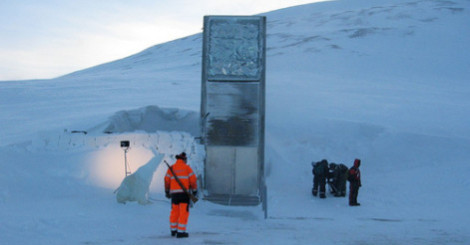

Last week we looked at how human activity impacted animal species around Chernobyl. This week, I thought we’d look at how human activity impacts other humans, for good and ill. First, the bad news. The civil war in Syria has uprooted millions of it citizens. Among the diaspora are scientists who study the genetics of food crops. Their work was significant for its scope, its catalog of hardy strains that feed hardy people in challenging climates, and its connections to the history of agriculture. The loss of this program would have profound consequences far beyond the borders of Syria.
Fortunately, we humans have our good moments as well. Enter the Svalbard Global Seed Vault. We’ve been banking seeds in an abandoned coal mine in Norway for a rainy day. These seeds don’t represent as significant food source on their own; they are intended to restart the global agricultural enterprise in the event of a disaster that requires such a drastic response. The Syrian scientists have been dutifully sharing a portion of their seeds for this repository, and now they are able to make a withdrawal to resume their research in a new location. It’s not exactly the scenario imagined when the vault was created, but it seems a worthwhile use. And experience in electronic data preservation indicates backups should be used regularly so you know they are viable, so maybe this is a good way to keep the vault fresh anyway.
It reminds me a little of the story of Joseph in Egypt, socking away surplus grain for seven years to be prepared for a prolonged drought. It’s nice to know were still capable of that kind of foresight, at least once in a while. Although it’s interesting that we’re using the seed vault for a different scenario than the one that motivated its creation. How knowable is the future? Do the limits of our predictive power have implications for our culpability when we fail to prevent negative consequences? Next week, I’ll be reviewing a book that explores those questions.
Andy has worn many hats in his life. He knows this is a dreadfully clichéd notion, but since it is also literally true he uses it anyway. Among his current metaphorical hats: husband of one wife, father of two teenagers, reader of science fiction and science fact, enthusiast of contemporary symphonic music, and chief science officer. Previous metaphorical hats include: comp bio postdoc, molecular biology grad student, InterVarsity chapter president (that one came with a literal hat), music store clerk, house painter, and mosquito trapper. Among his more unique literal hats: British bobby, captain’s hats (of varying levels of authenticity) of several specific vessels, a deerstalker from 221B Baker St, and a railroad engineer’s cap. His monthly Science in Review is drawn from his weekly Science Corner posts — Wednesdays, 8am (Eastern) on the Emerging Scholars Network Blog. His book Faith across the Multiverse is available from Hendrickson.

Leave a Reply